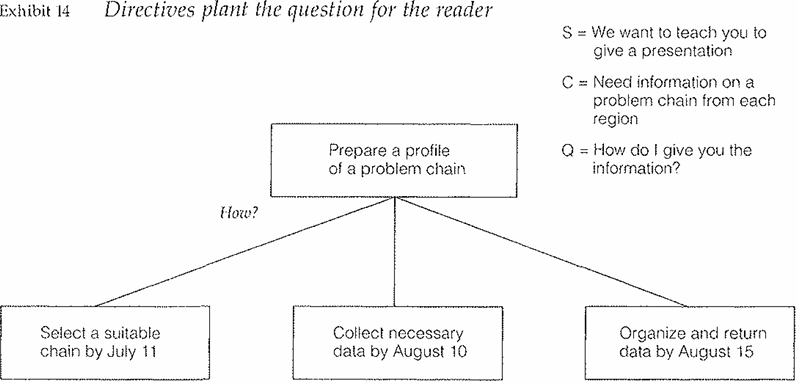
Giving Direction
 المؤلف:
BARBARA MINTO
المؤلف:
BARBARA MINTO
 المصدر:
THE MINTO PYRAMID PRINCIPLE
المصدر:
THE MINTO PYRAMID PRINCIPLE
 الجزء والصفحة:
50-3
الجزء والصفحة:
50-3
 2024-09-11
2024-09-11
 959
959
Giving Direction
A directive must be the most common kind of business memorandum written anywhere in the world-reflecting a situation in which you write to ask or tell someone else to do something. In this case, you will be planting the question in the reader's mind rather than reminding him of it.
To illustrate, suppose you are holding a meeting for your field salesmen, at which you are planning to teach them how to present a new technique for organizing shelf space in chain grocery stores. However, in order to do so effectively you need some information from each on a particular problem chain in his local area. How would you structure the introduction? Very much in this manner:
S = At the field sales meeting we want to teach you how to present the new Space Management Program
C = To do so, we need information on a problem chain in your area
Q = (How do I give you the information?)
Or, to put it as starkly as possible:
S = We want to do X
C = Need you to do Y
Q = How do we do Y?
In this case the question would be implied rather than stated, since the flow of the writing would not require it to be spelled out. Nevertheless, you should absolutely spell it out for yourself before you begin to write. Otherwise, you run the danger of not being sure of your question.

In this example, the question is "How?" Whenever the question is "How?" the answer is invariably "steps," so that you would end up with a structure something like that shown in Exhibit 14. Note also that the Complication and the Answer are roughly reversals of each other, since the Answer is the effect of carrying out the actions, which of course would solve the problem.
To try another example, suppose you have a procedures manual that various people in the company update or add to, and you want to make sure they all do it in the same way:
S = We have a manual covering activities where nonconformity of action would be detrimental. From time to time it needs updating.
C = To ensure compatibility, it is important to follow the same procedure.
Q = (What is the procedure?)
And again you have another question that would be implied rather than stated in writing. To show the pattern starkly:
S = You do X
C = Must do in Y way
Q = What is Y way?
 الاكثر قراءة في Writing
الاكثر قراءة في Writing
 اخر الاخبار
اخر الاخبار
اخبار العتبة العباسية المقدسة


